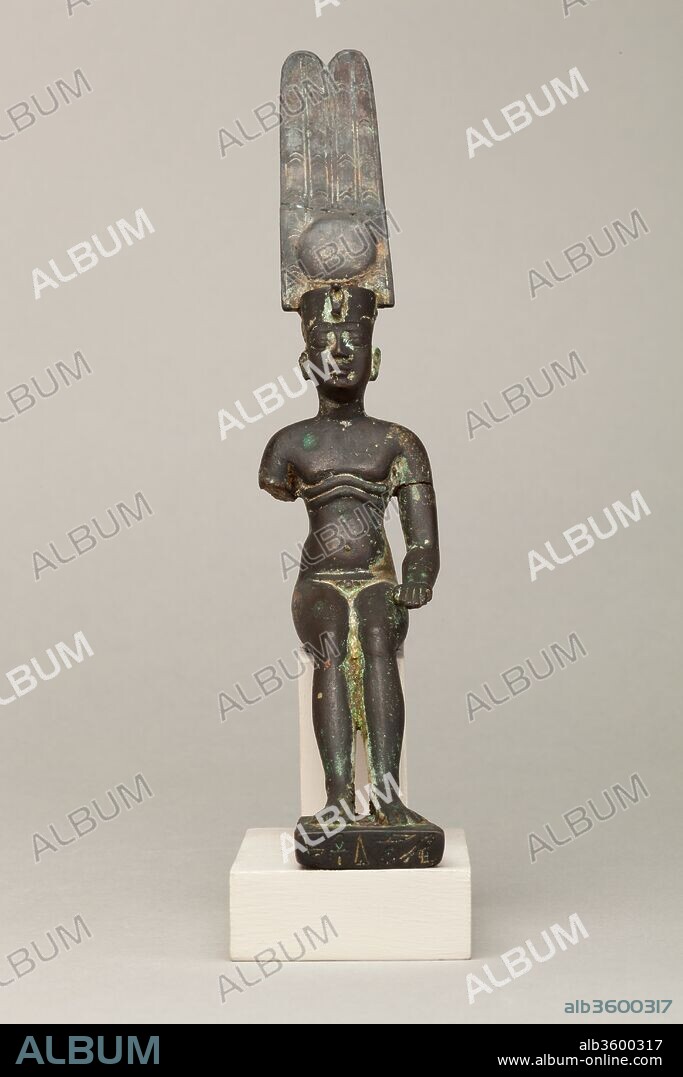alb3600317
Child god wearing Amonian crown and named Horus of Mednit (Aphroditopolis)

|
Zu einem anderen Lightbox hinzufügen |
|
Zu einem anderen Lightbox hinzufügen |



Haben Sie bereits ein Konto? Anmelden
Sie haben kein Konto? Registrieren
Dieses Bild kaufen.
Nutzung auswählen:

Titel:
Child god wearing Amonian crown and named Horus of Mednit (Aphroditopolis)
Untertitel:
Automatische Übersetzung: Kindergott, der eine amonische Krone trägt und Horus von Mednit (Aphroditopolis) genannt wird. Abmessungen: H 18,3 cm (7 3/16 in.); B. 4 cm (1 9/16 in.); D. 11,1 cm (4 3/8 in.). Datum: 664-30 v. Die Figur stellt einen Kindergott in sitzender/liegender Position dar, der die doppelte Federkrone trägt, die ihn mit dem Gott Amun in Verbindung bringt. Der Kindergott unterscheidet sich normalerweise von erwachsenen Göttern durch eine Reihe von ikonografischen Hinweisen: seine Nacktheit, der zum Mund erhobene Finger (eine kindliche Geste) und eine Seitenlocke auf der rechten Seite seines Kopfes. Der rechte Arm dieser Figur ist gebrochen, und daher ist die Position der Hand unbekannt; wahrscheinlich wurde es an seinem Mund oder an seiner Seite gehalten, wie der linke Arm. Auch das Schläfenschloss ist nicht zu sehen, aber seine Nacktheit reicht aus, um ihn als Kindergott zu identifizieren. Unter seinen Brustmuskeln hat der Kindergott zwei stilisierte Fettröllchen, ein Merkmal, das bei dieser Art von Statuetten sehr ungewöhnlich ist. Trotzdem werden viele Kindergötter mit runden oder pummeligen Bäuchen gezeigt, was die Fähigkeit des Gottes zeigt, Wohlstand und Überfluss zu schaffen. Diese fetten Brötchen drücken die gleichen Ideen aus. Kindergötter gewannen ab der Dritten Zwischenzeit an Popularität und Kult und konkurrierten sogar mit den mächtigsten und ältesten Göttern, insbesondere als Tempelopfer. Aufgrund ihrer Fülle und vieler lokaler Formen ist es im Allgemeinen sehr schwierig, Kindergottheiten genau zuzuordnen, aber eine Inschrift auf dem Sockel benennt diese Figur als Horus von Mednit.
Child god wearing Amonian crown and named Horus of Mednit (Aphroditopolis). Dimensions: H. 18.3 cm (7 3/16 in.); W. 4 cm (1 9/16 in.); D. 11.1 cm (4 3/8 in.). Date: 664-30 B.C..
The figure represents a child god in a seated/reclining position, wearing the double feather crown, which associates him with the god Amun. The child god is usually distinguished from adult gods by a range of iconographic clues: his nudity, the finger raised to the mouth (a child-like gesture), and a sidelock on the right side of his head. The right arm of this figure is broken, and thus the position of the hand is unknown; likely it was held at his mouth or at his side, like the left arm. The sidelock also is not in evidence, but his nudity suffices for identification as a child god. Below his pectorals, the child god has two stylized fat rolls, a feature that is very uncommon on these types of statuettes. Nevertheless, many child gods are shown with rounded or chubby bellies, showcasing the god's ability to bring about prosperity and abundance; these fat rolls express the same ideas.
Child gods grew in popularity and cult from the Third Intermediate Period onwards, rivaling even the most powerful and ancient gods, especially as temple offerings. Because of their profusion and many local forms, generally it is very difficult to assign precise identities to child gods, but an inscription on the base names this figure as Horus of Mednit.
Technik/Material:
Cupreous metal
Zeitraum:
Late Period-Ptolemaic Period
Museum:
Metropolitan Museum of Art, New York, USA
Bildnachweis:
Album / Metropolitan Museum of Art, NY
Freigaben (Releases):
Model: Nein - Eigentum: Nein
Rechtefragen?
Rechtefragen?
Bildgröße:
2934 x 4400 px | 36.9 MB
Druckgröße:
24.8 x 37.3 cm | 9.8 x 14.7 in (300 dpi)
Schlüsselwörter:
 Pinterest
Pinterest Twitter
Twitter Facebook
Facebook Link kopieren
Link kopieren Email
Email
